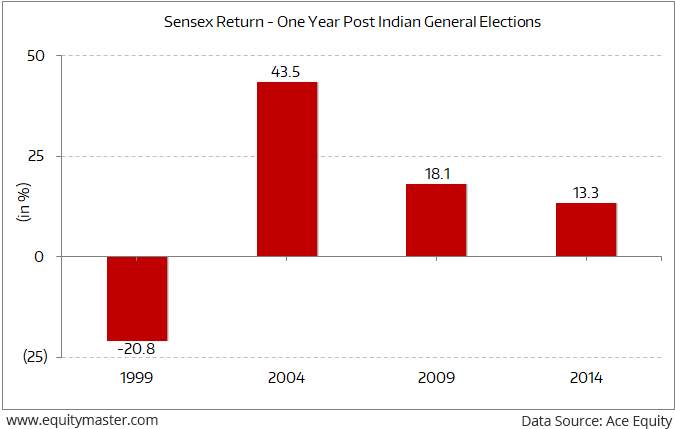Indian Indices End On A Flat Note; IT & Auto Stocks Witness Selling
Indian share markets traded range-bound throughout the day and ended their session on a flat note. Sectoral indices ended on a mixed note with stocks in the consumer durable sector, oil & gas sector and realty sector witnessing buying interest while IT stocks and auto stocks witnessed selling pressure.
At the closing bell, the BSE Sensex stood lower by 38 points and the NSE Nifty closed down by 14 points. The BSE Mid Cap index ended the day up by 0.5% and the BSE Small Cap index ended up by 0.9%.
Asian stock markets finished on a negative note. As of the most recent closing prices, the Hang Seng was down by 0.4% and the Shanghai Composite was down by 0.5%. The Nikkei 225 was down 0.8%.
The rupee is trading at 71.08 against the US$.
Speaking of Indian stock markets, the recent volatility seen in markets has given the opportunity to load up on quality stocks.
The volatility started with the long-term capital gains tax.
Then corporate governance issues at various companies followed.
Then we had the IL&FS impact.
All this has ensured a rough ride for Indian investors.
Now with Indo-Pak tensions escalating, volatility can rise even further.
With the elections fast approaching, what can investors look forward to now?
Here's what Tanushree Banerjee, Editor, The 5 Minute WrapUp, has to say about this...
- History of the past few elections paints a rosy picture.
Despite governments changing hands in 2004 and 2014, the Sensex gave returns of 44% and 13% in a year respectively.
Even in 2009, when the same government retained power, Sensex was up by 18% in a year.
Good Times Ahead for Indian Stock Markets?

As per Tanushree, the recent volatility throws an opportunity to load up on quality stocks. These stocks will piggyback on India's long-term growth story.
She believes these stocks will rise fast when the tide of the market turns up.
In the news from the telecom sector, Bharti Airtel share price was in focus today on the back of company's board meeting which will finalise the company's fundraising plans as the second-largest telco aims to create a war chest to contain debt and meet capital expenditure needs for bolstering its 4G networks to fight Reliance Jio Infocomm.
In the news from the automobiles space, as per a leading financial daily, The centre will soon announce a subsidy up to Rs 2.5 lakh for 60,000 electric cars and a dole of Rs 20,000 for 20,000 hybrid cars that are bought in the next three years.
The Rs 100 billion package will give the green fuel the much-needed push in India.
As per the news, most of the funds in this package will be contributed to electric two and three-wheeler vehicles and buses used for public transport, and e-rickshaw drivers can also avail this subsidy.
The above proposal may be taken up by the Cabinet today as part of the second phase of Faster Adoption and Manufacturing of (Hybrid and Electric Vehicles) India (FAME) scheme.
Note that the government wants to see fast results on the electric vehicles front, therefore, it doubled allocation to the scheme from the earlier Rs 55 billion.
Once finalized, the subsidy will come into effect in April.
Under this scheme, the government will also cap ex-factory price of a vehicle, except buses, to avail the subsidy, at Rs 15 lakh. The subsidy for any vehicle will be calculated on the basis of its battery capacity - Rs 10,000 per KWh for all vehicles and Rs 20,000 per KWh for buses.
Speaking of electric vehicles, note that the government is targeting to have all cars propelled by electric engine by 2030. The target is more daunting than in many advanced countries.
According to the industry, the 2030 target would require eight to ten times the global stock of such vehicles. India would need to sell more than 10 million electric cars in 2030, compared to 5,000 electric vehicles India had on the road in 2016.
India is barely visible compared to other developed countries when it comes to battery cars.
But such a big jump in scale for the auto industry in 13 years seems difficult. The basic infrastructure is missing. There are not enough charging stations. For this massive shift, the charging stations will need to be as ubiquitous as petrol pumps.
Another issue is the price of the lithium-ion battery, which constitutes 30% to 40% of the cost of the car. For this plan to succeed, the price of the battery needs to come down.
The auto industry is already facing regulatory headwinds. The shift from BS-IV emission norms to BS-VI has been two years ahead of schedule without an intermediate stage. The government, if it is serious about such ambitious targets, should offer the necessary infrastructure support and do its bit for a smooth transition.
We will keep you updated on all the developments from this space. Stay tuned.
To know what's moving the Indian stock markets today, check out the most recent



